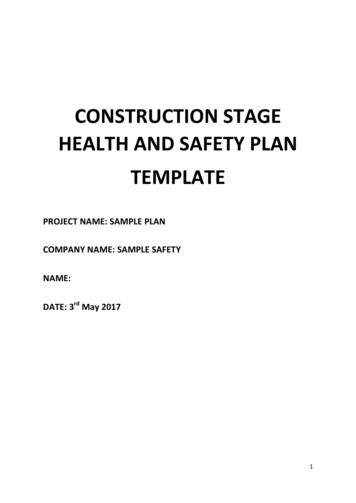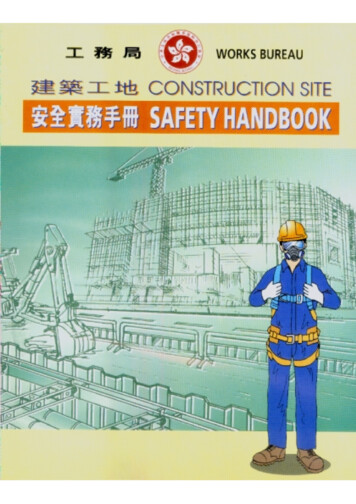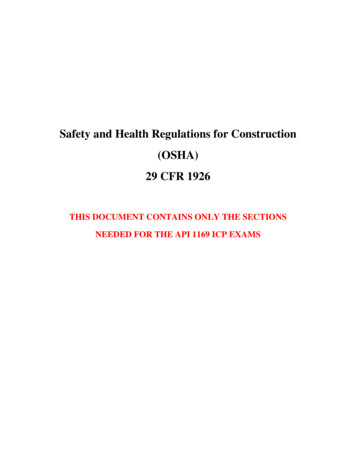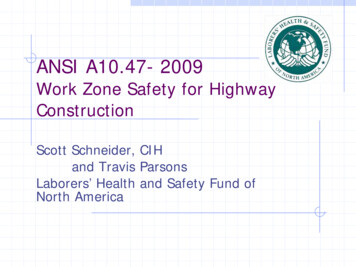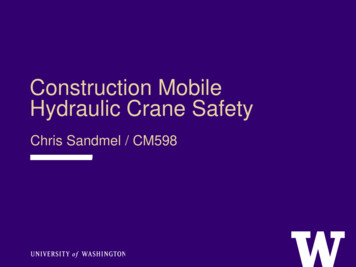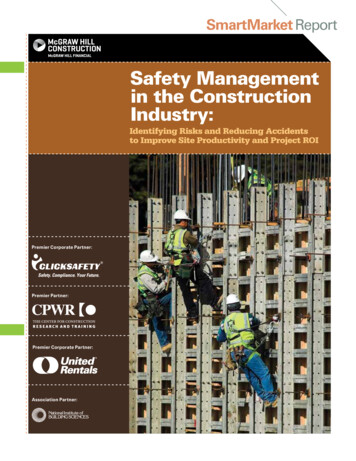
Transcription
SmartMarket ReportSafety Managementin the ConstructionIndustry:Identifying Risks and Reducing Accidentsto Improve Site Productivity and Project ROIPremier Corporate Partner:Premier Partner:Premier Corporate Partner:Association Partner:
Design and Construction IntelligenceSmartMarket ReportMcGraw Hill ConstructionPresidentKeith FoxVice President, Product DevelopmentKathryn E. CassinoSafety Management in theConstruction Industry:Identifying Risks and ReducingAccidents to Improve SiteProductivity and Project ROISmartMarket ReportExecutive EditorMcGraw Hill ConstructionDodge Research & Analytics/Industry Insights & AlliancesVice President, IndustryInsights & AlliancesHarvey M. Bernstein, F.ASCE, LEED APEditorial DirectorMichele A. Russo, LEED APManaging EditorHarvey M. Bernstein, F.ASCE, LEED APDonna Laquidara-Carr, Ph.D., LEED APSenior Director, Research & AnalyticsEditorBurleigh MortonEnver Fitch, LEED Green AssociateDirector, Research CommunicationsDirector,Design & ProductionMichele A. Russo, LEED APWilliam TaylorReproduction or disseminationof any information containedherein is granted only by contractor prior written permission fromMcGraw Hill Construction.Copyright 2013,McGraw Hill Construction,ALL RIGHTS RESERVEDManager, Content OperationsJuan RamosArt DirectorAlison LorenzContributing Art DirectorAD-BOUTIQUE, INC.Hisako FujishimaContributorsSteve JonesBelle Communications, LLCBruce BuckleyResearch Project ManagerDana Gilmore, MRA, PRCFor further information on thisSmartMarket Report or for anyin the series, please contact:McGraw Hill ConstructionResearch & Analytics34 Crosby Drive, Suite 201Bedford, MA 017301-800-591-4462MHC Analytics@McGraw-Hill.comAbout McGraw HillConstructionMcGraw Hill Constructionprovides essential data, news,insights, and intelligence to betterinform construction professionals’decisions and strengthen theirmarket position.McGraw Hill Construction’s data,analytics, and media businesses—Dodge, Sweets, ArchitecturalRecord, GreenSource, and Engineering News-Record—createopportunities for owners, architects, engineers, contractors,building product manufacturers, and distributors to strengthentheir market position, size theirmarkets, prioritize prospects, andtarget and build relationships thatwill win more business. McGrawHill Construction serves more thanone million customers throughits trends and forecasts, industry news, and leading platform ofconstruction data, benchmarks,and analytics, including DodgeMarketShare , Dodge BuildShare and Dodge SpecShare .Construction data is availablefor North American and globalmarkets.To learn more,visit www.construction.com.
SmartMarket reportSafety ManageMent in the ConStruCtion induStryIntroductionver the last 20 years, the practiceof construction has undergoneprofound changes.the types ofprojects, the manner in whichthose projects are delivered and the toolsused for design and communication, all havechanged dramatically. additionally, newtechnologies, such as building informationmodeling (BiM), have enabled projectsto become more complex.therefore, itis essential for contractors to have a fullyintegrated, extensive safety program thatcan respond to evolving industry needs andallow them to stay competitive.the results of the study on projectsafety featured in this SmartMarket Reportdemonstrate that the adoption of safetypractices are different between generalcontractors and subcontractors, aswell as between small and large firms(though these factors are correlated).While over two thirds (67%) of the industryoverall report having a fully inclusiveand widely observed safety program,an extensive program is far morecommon for large firms: 92% of firms with over 500 employeesreport this high level of safety program. 48% of firms with less than 50 employeesreport the same.Oin order to increase adoption of strongersafety management programs, firms,especially smaller firms, need data to helpmake the case for these programs. thisstudy reveals some of the key benefits ofthese programs:Harvey M. Bernstein, F.ASCE,LEED AP, has been a leader inthe engineering and construction industry for over 30 years.Currently, he has lead responsibility for MHC’s market researchgroup as well as MHC’s thoughtleadership initiatives in areassuch as green building, BIM,interoperability, innovation andglobal construction markets.Previously, Bernstein servedas the President and CEO ofthe Civil Engineering ResearchFoundation. He currently servesas a member of the PrincetonUniversity Civil and Environmental Engineering AdvisoryFaster Project Schedule: Reported by43%, with half of these expecting savingsof a week or more. Higher Project ROI: Reported by 51%,with 73% of these expecting an increaseby 1% or more. Project Budget: Reported by 39%,with 73% of these expecting decreasesof 1% or more. a good safety program also improvescompetitiveness in less tangible ways.eighty-two percent report the positiveimpact of their safety program on theircompany’s reputation, a factor that helpsattract talent and new business.The study also demonstrates that criticalindustry trends, such as the use of BIM andprefabrication, are having powerful positiveimpacts on project safety. BIM: 43% of the firms using BIM reportthat it improves site safety. Prefabrication/Modularization: 49% offirms using prefabrication/modularizationfind it improves site safety.the importance of these trends isreinforced by the fact that firms using BiMor prefabrication have significantly higheradoption levels of nearly all the safetypractices measured in the survey.as the industry looks to increaseproductivity and competitiveness, loweringproject risk through strong safety practicesis increasingly important. We would liketo thank our primary partners, ClickSafetyand CPWr, for helping us bring this criticalinformation to the construction industry.Council and as a visitingProfessor with the University ofReading’s School of Construction Management and Engineering in England. Bernstein has anM.B.A. from Loyola College, anM.S. in engineering from Princeton University and a B.S. incivil engineering from the NewJersey Institute of Technology.Michele A. Russo, LEED AP,is responsible for managingMHC’s SmartMarket Reportseries and market insightsprogram, leading to over 30 keyindustry trend reports producedsince 2005. Drawing from herMcGraw Hill Constructionmore than 18 years of experience tracking environmentalpolicy trends, Michele also helpsdirect the green content acrossMHC’s portfolio of productsand services. Previously, sheserved as Executive Director ofthe Clean Beaches Council andDeputy Director of the NationalPollution Prevention Roundtable. Russo has a B.S. in chemicalengineering from Cornell University and a master’s in publicpolicy from Harvard University’sKennedy School of Government.Donna Laquidara-Carr,Ph.D., LEED AP, currently1www.construction.comHarvey M. BernsteinF.ASCE, LEED APVice PresidentIndustry Insights & AlliancesMcGraw Hill ConstructionMichele A. RussoLEED APDirectorResearch CommunicationsMcGraw Hill ConstructionDonna Laquidara-Carr,Ph.D., LEED APManager, Industry Insights &Research CommunicationsMcGraw Hill Constructionprovides editorial direction,analysis and content to MHC’sSmartMarket Reports. Prior tostarting this position in 2008,she worked for nearly 20 yearswith MHC’s Dodge division,where she gained insight intothe construction news industry.From 2005–2008, she served asEditorial Training and PolicyManager, responsible foreducating over 250 reporterson key trends in the industry.Laquidara-Carr has a Ph.D. fromTulane University, an M.A. fromBoston University and a B.A.from Middlebury College.SmartMarket Report
SmartMarket ReportSAFETY MANAGEMENT IN THE CONSTRUCTION INDUSTRY:IDENTIFYING RISKS AND REDUCING ACCIDENTS TO IMPROVE SITE PRODUCTIVITY AND PROJECT ROITABLE OFCONTENTS4 Executive Summary4 Executive Summary6 Recommendations7 Data8 Types of Safety Practices8 Types of Practices Used to Promote Safety on Projects10 Top Practices to Increase Safety on Projects11 Implementing New Safety Practices in the Next Three Years12 Level of Integration of Safety Policies and Programs13 Aspects of a World-Class Safety Program15SIDEBARIntegration of Safety and Quality Management16 Impact of Safety Practices/Programs on Business16 Impact of Safety Practices on the Success of Projects18 Impact of Safety Practices on Project Schedule19 Impact of Safety Practices on Project Budget20 Impact of Safety Practices on Project ROI21 Impact of Safety Practices on Injury Rates22SIDEBARUsing Leading Metrics to Improve Safety Management23 Influence Factors23 Factors Driving Adoption of Current Safety Management PracticesFront Cover: Dwight Smith/Shutterstock.com. Opposite Page: Both images from iStockphoto/Thinkstock24 Factors Encouraging Future Investment in More Extensive Safety Management Practices25 Factors Discouraging Investment in More Extensive Safety Management Practices26 Top Influential People Impacting Improvement of Safety Management Practices28 Communication and Education28 Impact of Safety Training and Orientation on Construction Firm Employees29 Entities that Conduct Safety Training for Jobsite Workers29 Safety Training Conducted Online30 Requiring OSHA 10 and OSHA 30 Training31 Types of Safety Training and Orientation for Jobsite Workers32 Types of Safety Training and Orientation for Foremen and Supervisors33 Importance of Safety Training for Jobsite Workers34 Value of Safety Training for Senior Management35 Frequency of Formal Safety Training for Jobsite Workers36SIDEBARSafety Training in the Construction Industry37 Most Effective Means of Communicating About Safety with Employees38 Top Sources of Health and Safety InformationSmartMarket ReportMcGraw Hill Construction2www.construction.com
CONTENTS39 Technology and Safety Management39 Impact of Building Information Modeling (BIM) on Site Safety40 Top BIM Functions for Improving Safety40SIDEBARUse of Building Information Modeling (BIM) in Construction41 Stages in BIM Process at Which Safety Personnel Get Involved42SIDEBAREmerging Ways to Use BIM to Enhance Safety43 Use of Mobile Devices on the Jobsite45 Staff Using Mobile Devices46 Impact of Mobile Devices on Safety47 Building Processes and Safety Management47 Impact of the Use of Prefabrication and Modularization on Safety48 Aspects of the Use of Prefabrication and Modularization That Contribute to Project Safety49SIDEBARRenewed Interest in Prefabrication and Modularization in Construction50 Specific Safety Training for Green Technologies, Practices or Products50 SIDEBAR Green Projects and SafetyThought Leader Interviews27 Charles A. Bacon, III, Chairman & CEO, Limbach Facility Services51 Yancy Wright, Director, Sellen Sustainability52 Methodology53 ResourcesMcGraw Hill Construction3www.construction.comSmartMarket Report
Safety ManageMent in the ConStruCtion induStryExecutive SummaryContractors are seeing significant positive impacts from investingin strong safety management programs, benefits that can helpdrive wider adoption of safety practices in the industry.the positive impacts reported by firms include reduced injury rates and improved reputations, as well as improvedproject roi and decreased schedules and budgets. Large firms are more widely adopting safety managementpractices and benefiting from these outcomes than small firms. in addition, important industry trends, such as theuse of building information modeling (BiM) and prefabrication and modularization, are improving safety outcomesfor firms that have embraced these new approaches.Contractors are ExperiencingPositive Business OutcomesFrom Safety ProgramsPositive and Negative Impacts of SafetyPrograms on Projects71%Source: McGraw Hill Construction, 2013Contractors experience strong productivity improvements due to their adoption of safety, includingschedule, budget and project ROI benefits. Clearly,investments in a safety management program offerstrong dividends on individual projects. among firms thatreport these positive impacts, the level of benefit theyachieve is also striking. 50% report a decrease in project schedule by one weekor more. 73% report decrease of project budget by 1% or more,with 24% noting a decrease of greater than 5%. 73% also report increase in project ROI by 1% or more,with 20% noting an increase of greater than 5%.Positive ImpactNegative ojectSchedulein addition, contractors also see other types of businessbenefits, such as: Improved Reputation: 82% Increased Ability to Contract New Work: 66% Improved Project Quality: 66%ReportableInjuriesLevel of Adoption of Safety Practicesand PoliciesSource: McGraw Hill Construction, 201392%given the relatively low cost of instituting safety practices, these benefits can help drive companies, especiallysmaller firms, to justify greater investments in their safetymanagement programs.Small Firms(1 to 49Employees)Medium Firms(50 to 499Employees)Large Firms Are Adopting SafetyPolicies and Practices More WidelyThan Small FirmsMcGraw Hill Construction76%48%35%Throughout the report, our findings demonstrate thatfirm size is directly correlated to the level of adoption ofsafety policies and programs, with large firms leadingthe industry. nearly double (92%) the percentage of largefirms with 500 or more employees report having a fullyinclusive and widely observed safety program than firmswith 1 to 49 employees (48%).SmartMarket ReportLarge Firms(500 or MoreEmployees)20%17%4%8%0%Occasionally ConductSafety Reviews WithNo Formal Policy4Not Fully Integratedwww.construction.comFully Inclusive andWidely Observed
Safety ManageMent in the ConStruCtion induStryExecutive SummarycontinuedImpact of BIM on Site Safety(according to respondents that use BiM)With construction firms averaging approximately 10employees, these data results demonstrate the need forgreater knowledge about safety impacts in the industryto encourage adoption among smaller firms, so they cansee that they do not need extensive resources to implement stronger programs. the link between safer jobsitesand their benefits, such as avoiding high dollar lossescaused by injuries, lower insurance rates and less business disruptions, must be emphasized.despite a strong differential in the level of adoption,large and small firms rank many practices at the samelevel. The top three practices noted as the most effectivefor increasing site safety reveal the importance of delivering safety practices directly to the site and beginningthe process of incorporating safety as early as possible. Develop Site-Specific Health and Safety Plan (HASP) Analyze Potential Site Hazards in Preconstruction Appoint/Assign/Authorize Project Safety PersonnelSource: McGraw Hill Construction, 20134%Positive ImpactNo Impact53%Impact of Prefabrication/Modularization onSite Safety (according to respondents that usePrefabrication/Modularization)Use of BIM, Mobile Tools andPrefabrication Have Positive Impactson SafetySource: McGraw Hill Construction, 20134%Positive ImpactNo ImpactBIM and PrefaBrIcatIon/ModularIzatIonin addition to the direct impact on safety noted on thecharts at right, use of BiM and prefabrication/modularization have broader implications on strong safety practices. A higher percentage of firms using BIM and firmsemploying prefabrication/modularization report usingall the safety practices in the study, with most of thedifferences being statistically significant. 83% of BIM users and 73% of prefabrication/modularization users report having a fully inclusive and widelyobserved safety program. A higher percentage of BIM users report achievingnearly all the benefits of safety measures in the survey.49%Negative Impact47%Onsite Safety Training and EducationConsidered the Most ValuableNinety-five percent of firms report using on-the-jobtraining, and 82% consider it to have the greatest valueto jobsite workers. this preference is consistent acrossall firm sizes and types, and it aligns with the importanceassigned to delivering training to those on the jobsitethat is also reported. online training is still emerging as atrend in the industry.While both BiM and prefabrication offer many opportunities to improve project safety directly, their use alsoencourages contractor involvement in projects beforeconstruction begins, a key factor for improving safety.Factors Driving Adoption ofSafety PracticesMoBIle toolsa wide range of mobile devices are reported as havinga positive impact on safety. the devices that are seen ashaving the greatest impact on safety: Smartphone other than iPhone (82%) iPad (81%) iPhone (78%)McGraw Hill Construction43%Negative ImpactOver 70% of contractors report that worker healthand well-being (79%), insurance costs (78%) and liability concerns (77%) are the top drivers for investment intheir safety programs, demonstrating that businessesare largely motivated by financial incentives, as well asconcern for workers, in their investment decisions.5www.construction.comSmartMarket Report
Safety ManageMent in the ConStruCtion induStryRecommendationsIn order to increase the adoption of safety practices in the industry,players from across the industry must engage in promoting the useof a wide range of safety management practices by contractors.hilecontractorshave themost directimpact on the adoptionof safety managementpractices, increasing projectsafety does not benefitthem alone.the industryas a whole would benefitby being able to attracttalent if it had a better safetyreputation, and projectowners would benefit fromprojects with less insuranceliability, shorter schedulesand improved budgets.WOwnersRequiRe a full Rangeof safety pRacticesnearly two thirds of thecontractors surveyedsaid that stronger ownerrequirements wouldencourage them to developa more extensive safetymanagement program.RequiRe eaRlieRcontRactoR involvement in pRojectsthe contractor is the mostimportant, well-informedand influential player inencouraging overall projectsafety.therefore, having thecontractor, and especiallythat firm’s safety personnel,engaged during the designand preconstruction phasescan help avoid someSmartMarket ReportIndustryAssociations andOrganizationshazards and mitigate othersthat are unavoidable.thisincludes involvement bythe major trades, such asmechanical and electricalcontractors, as well assubcontractors.pRovide moRe dataon the BusinessBenefits of safetyMany of the main obstaclescited by firms, includingincreased cost and lowerproductivity, are areas inwhich investment in safetycan improve performance.More hard data on thesesavings can help firmsencourage their seniorleadership to investin greater safetymanagement practices.encouRageuse of Bim andpRefaBRicationforty-three percent of thecontractors surveyed reportthat BiM use improvesproject safety, and nearlyhalf of those using BiM citethe ability to identify sitehazards before constructionbegins as a major factor,with clash detection alsonoted by nearly a quarter.these findings suggestthat encouraging BiMuse could have a materialimpact on safety.in addition, 49% ofcontractors find thatusing prefabrication/modularization on projectshas a positive impact onsafety. While prefabricationis not a universal solution,it is still underutilized in theindustry, and interest inthese approaches by projectowners when appropriatewould encourage wideruse, thereby potentiallyimproving site safety.McGraw Hill Constructionapply pRessuReto the insuRanceindustRy to ReducecontRactoR insuRance Rates Basedon use of a stRongsafety managementpRogRamSeventy-eight percentof contractors considerreduced insurance ratesa strong incentive to helpfund their investmentsin safety programs.industry associations andorganizations have morecollective clout to advocatefor change in rate policies.6www.construction.comContractorsimplement safetypRactices fRom theBottom upthe study results consistentlydemonstrate that safetypractices implemented on thej
M.B.A. from Loyola College, an M.S. in engineering from Princ-eton University and a B.S. in civil engineering from the Ne Jersey Institute of Technology. Michele A. Russo, LEED AP, is responsible for managing MHC’s SmartMarket Report series and market insights program, leading t





